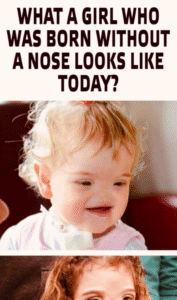The story of the “Noseless Girl” is not just one of medical rarity—it’s a testament to resilience, evolving beauty, and the power of redefining what it means to be whole. Today, she is not just a girl who was born without a nose; she is a symbol of transformation, courage, and the quiet triumph of self-acceptance.
🌱 Born Without a Nose: The Beginning
Tessa Evans was born with a rare condition called arhinia, meaning she had no nose—not even nasal passages or sinuses. At birth, her appearance startled many, but her parents saw something else: a radiant child whose difference only deepened her uniqueness. They chose not to hide her. Instead, they shared her story with the world, inviting others to witness the beauty of imperfection and the strength of unconditional love.
🛠️ Medicine Meets Art: A New Kind of Reconstruction
Rather than opting for traditional facial reconstruction, Tessa’s family worked with pioneering surgeons to develop a groundbreaking approach. Instead of building a nose immediately, they implanted a small, 3D-printed structure beneath her skin—designed to grow with her face. This method allowed her to maintain her natural features while preparing for a more refined nasal implant later in life.
It was a bold choice. The goal wasn’t just cosmetic—it was philosophical. Her parents wanted her to grow up proud of who she was, not feeling like she had to “fix” herself to be accepted.
📸 What She Looks Like Today
Now in her early teens, Tessa’s face tells a story of evolution. Her features have matured, her confidence has blossomed, and her presence is magnetic. The nasal implant has subtly shaped her profile, but what stands out most is her eyes—bright, expressive, and full of life. Her smile carries the weight of someone who’s faced the world’s gaze and chosen to meet it head-on.
She doesn’t look like everyone else. And that’s precisely the point.
🎭 Beyond the Mirror: Identity and Representation
Tessa’s journey has sparked broader conversations about representation in media and medicine. In a world saturated with filtered perfection, her story reminds us that beauty is not symmetry—it’s authenticity. She’s appeared in interviews, documentaries, and social media posts, often accompanied by messages of body positivity and self-love.
Her presence challenges the norms of what we expect from “inspirational” stories. She’s not just surviving—she’s thriving. And she’s not here to be pitied; she’s here to be seen.
🧬 The Science Behind Arhinia
Arhinia is extraordinarily rare, with fewer than 100 documented cases worldwide. It occurs during early fetal development when the nasal structures fail to form. While the condition can be associated with other anomalies, Tessa’s case was isolated—making her a candidate for innovative surgical approaches.
Doctors had to rethink everything: how to help her breathe, how to support facial growth, and how to preserve her identity. The result was a collaboration between medicine, engineering, and artistry.
💬 Her Voice in the World
Tessa’s family has been vocal about their journey—not just the medical milestones, but the emotional ones. They’ve shared moments of doubt, joy, and fierce advocacy. Her mother once wrote, “We didn’t want her to grow up thinking she had to hide. We wanted her to know she was perfect just as she was.”
That message has resonated with thousands. Tessa’s story has become a beacon for families navigating rare conditions, and for anyone who’s ever felt “different.”
🖼️ Cultural Echoes: The Noseless Archetype
Interestingly, the idea of a “noseless girl” has appeared in fiction and animation too. In Pixar’s Win or Lose, a character named Lena appears without a nose—a design choice that sparked debate online. While Lena’s appearance is stylized, it unintentionally mirrors real-life stories like Tessa’s, raising questions about how we depict difference in media.
Is the absence of a nose a metaphor? A design quirk? Or a reflection of how we’re slowly expanding our visual vocabulary to include more diverse faces?
🌈 What She Represents Today
Tessa Evans is no longer just “the girl born without a nose.” She’s a young woman with dreams, opinions, and a growing sense of self. Her story is not frozen in time—it’s unfolding. And what she represents today is far more powerful than any headline:
- She represents innovation—how medicine can evolve to meet emotional and aesthetic needs.
- She represents visibility—how sharing one’s story can shift cultural perceptions.
- She represents choice—the right to define one’s own beauty, on one’s own terms.
🕊️ A Living Metaphor
If her face is a canvas, it’s one painted with courage. The absence of a nose is not a void—it’s a space filled with meaning. It invites us to look deeper, to question our assumptions, and to celebrate the stories that don’t fit neatly into conventional frames.
Tessa’s journey is a reminder that transformation isn’t always about becoming someone else. Sometimes, it’s about becoming more fully yourself.



